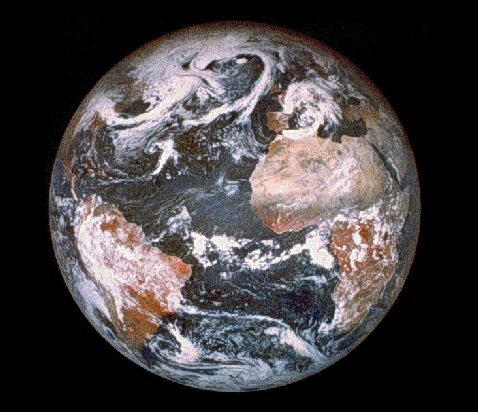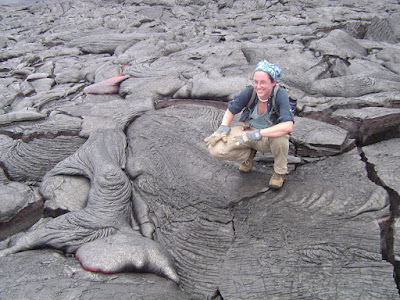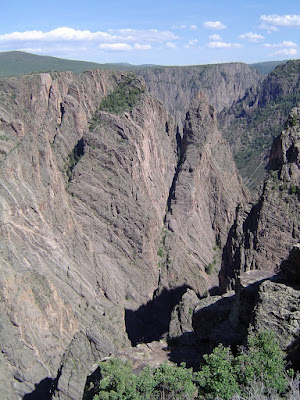Christie and
Callan have already put up their "geolutions" for 2009, so I thought I'd take a look at
some that I made a year ago, and make a few for the coming year.
There aren't many serious ones in the old list, and I made them fully expecting to break them, but let's see how I did:
#1. I will not succumb to apoplexy when approached and "corrected" by Flat Earthers, Creationists, IDers, Young Earth proponents, and followers of L. Ron Hubbard.
This didn't give me a lot of trouble - I only met one, and he was really polite. And he bought that runty rocking chair that I didn't like, thus making way for better furniture, so there was a good side to the encounter.
#2. I will not insist that we drive really slow or make u-turns (illegal or otherwise) whenever I see a really cool roadcut.
Fail. I must have slowed down to look at the carbonates exposed in Buffalo underpasses at least a dozen times since I moved there, and that's not counting the Niagara Falls excursion where I dragged my dad all over the Escarpment looking at outcrops.#3. I will only make the suggestion "Why don't you lick it?" in the appropriate setting and in the presence of other geologists.
Appropriate setting, yes. In the presence of other geologists, nope. I couldn't resist doing this to my intro lab students, who of course thought I was totally gross. (And then went and licked the salt anyway.)#4. I will recognize that having a grain size identification card in my wallet does, in fact, make me a geek.
Duly recognized. Remedied? Not on your life. That thing is really useful.#5. I will attempt to avoid a steady stream of snarky geologist commentary when watching
The Core, Dante's Peak, Volcano, The Day After Tomorrow, Armageddon, Jurassic Park, or
Deep Impact. (The second two
Jurassic Park movies and anything made or aired by the SCIFI channel is fair game.)
EPIC fail. The Core still makes me cringe, and I've hit the point in Jurassic Park where I've started keeping score of the dinos vs. humans competition. Dinosaurs are winning, natch.#6. I will remove the rocks from my handbags or, failing that, stop trying to claim that they are "crime prevention devices".
Yeah, I failed at this too. Then again, in parts of Costa Rica it definitely felt better to have those rocks handy.#7. I will not become angry when airport security thinks that the muddy boots / rock hammer / crack hammer / fossil chipper / twenty pounds of andesite / mapping clipboards / heavy-duty gloves / tent stakes / souvenir benchmark / GPS receiver / power tools are signs that I am dangerous / a graduate of a terrorist training camp / attempting to smuggle radioactive material between states / going to gouge a hole in the plane.
Costa Rica security wasn't too picky about the boots and gloves or the rocks I brought back. My kind of place. Guess I succeeded at something!#8. I will not drag my friends into the rock shop directly adjacent to the exit of the large cave we have been visiting for several hours.
Easy enough - I didn't visit any caves this year.
#9. I will remember that not everyone appreciates the joys of initiating a mass wasting event upon discovering large rocks at the top of a cliff.
Oh, this was so tempting at Niagara Gorge...
#10. I will get into graduate school, become part of a wonderful volcanology program, travel the world, write an award-winning popular science book and spend the rest of my life chasing down violent eruptions and spreading the good word about volcanic hazards. (Oops...a serious one!)
Two for five, and I'm fixing the traveling part come March!
Not bad at all. But what should I resolve for this coming year?
For Geolutions (some of which will actually happen, and some wishful thinking):
- Do my thesis field work at Santa Maria Volcano, Guatemala
- See Vesuvius, Stromboli, and Etna volcanoes, Italy
- Go bouldering in Niagara Glen (from the Canadian side)
- Climb to the crater of Mount St. Helens, Washington
- See the places Ed Abbey loved in Arches National Park, Utah
- Find something sparkly at Crater of Diamonds State Park, Arkansas
- Walk on the columnar basalt at Giant's Causeway, Bushmills, Northern Ireland
- Stop at the roadcut at Sideling Hill, Maryland
- Find a really cool trilobite fossil in the Rochester Shale near Lewiston, New York
- See the glaciers of Kilimanjaro - before it's too late
And in general:
- Get the hell out of my apartment once in a while and go do fun things. Everyone's right, grad school can be very isolating, and once it gets back into the 40s in Buffalo I can start thinking about some rock climbing and camping.
- Contacts. I am so unbelievably sick of my glasses breaking (three times in the past week).
- I won't let the impending four-lab teaching load of this next semester overstress me.
- Get that NSF Fellowship so I don't have to teach four labs in a semester and will actually have the time and money to do research.
- Finish writing the manuscript for the Fish Lake volcanic rocks so my old advisor has one less thing to stress about and I can finally see if I'm actually competent at this whole publishing thing. (Whether or not I give a talk at Rocky Mountain about the same is another story. Egads, me? A talk?)
- Stop thinking about work all the time. I can't get over this feeling that if I'm not doing work, I'm slacking and I don't deserve to spend time enjoying myself. Is this a grad school thing or just a W&M thing?
- FIELD WORK. I did very little field work last year due to the fact that my job was at a desk. (The field work I did do netted me a grand total of 16 ticks, which fortunately did not come with Lyme disease.)
- Play music more. As Julian knows, in addition to being a geologist I'm also an instrumentalist. My violin and mandolin and gamba have been very neglected this year, and I've forgotten how well they help me de-stress.
- Promote Earth Science Week next year. I always feel guilty that I don't try to get people involved, and it would be a great chance to interact with the undergrads (and maybe get the community a little more involved with the campus, because as far as I can tell, the two are totally isolated from each other).
- Keep writing! In addition to this blog, I'm also working on some volcano summary pages for Geology.com. The first one - Vesuvius - is already up, and I'm plugging away at some more Italian volcanoes. (Why the Italian emphasis? Half my family's from there, though you couldn't guess it by looking at me.)
All in all, not a bad list. Whether everything will get done depends heavily on the states of my pocketbook, schedule and sanity, but it will certainly be an interesting year.
 This is a strangely appropriate photo - it's from my 18th birthday party. Yes, that's a volcano cake. Yes, I am a dork. Then again, who wouldn't want a cake that erupts lava and destroys villages?
This is a strangely appropriate photo - it's from my 18th birthday party. Yes, that's a volcano cake. Yes, I am a dork. Then again, who wouldn't want a cake that erupts lava and destroys villages?





























































